Understanding Future Water Challenges in a Highly Regulated Indian River Basin—Modelling the Impact of Climate Change on the Hydrology of the Upper Narmada
Abstract
1. Introduction
2. Materials and Methods
3. Results
3.1. Basin Climatology
3.2. Simulated Scenario Discharge
4. Discussion
5. Conclusions
Author Contributions
Funding
Acknowledgments
Conflicts of Interest
References
- Madhusoodhanan, C.G.; Sreeja, K.G.; Eldho, T.I. Climate change impact assessments on the water resources of India under extensive human interventions. Ambio 2016, 45, 725–741. [Google Scholar] [CrossRef] [PubMed]
- Mall, R.K.; Gupta, A.; Singh, R.; Singh, R.S.; Rathore, L.S. Water resources and climate change: An Indian perspective. Curr. Sci. 2006, 90, 1610–1626. [Google Scholar]
- Gosain, A.K.; Rao, S.; Basuray, D. Climate change impact assessment on hydrology of Indian river basins. Curr. Sci. 2006, 346–353. [Google Scholar]
- Gupta, H.; Chakrapani, G.J. Temporal and spatial variations in water flow and sediment load in Narmada River Basin, India: Natural and man-made factors. Environ. Geol. 2005, 48, 579–589. [Google Scholar] [CrossRef]
- Government of India. National Water Policy; Department of Water Resources, Government of India: New Delhi, India, 2012.
- Rijsberman, F.R. Water scarcity: Fact or fiction? Agric. Water Manag. 2006, 80, 5–22. [Google Scholar] [CrossRef]
- Mishra, S.K.; Sahany, S.; Salunke, P. CMIP5 vs. CORDEX over the Indian region: How much do we benefit from dynamical downscaling? Theor. Appl. Climatol. 2017, 133, 1–9. [Google Scholar] [CrossRef]
- IPCC AR5 Climate Change 2013: The Physical Science Basis—IPCC. Available online: https://www.ipcc.ch/report/ar5/wg1/ (accessed on 20 April 2020).
- Mukherjee, S.; Aadhar, S.; Stone, D.; Mishra, V. Increase in extreme precipitation events under anthropogenic warming in India. Weather Clim. Extrem. 2018, 20, 45–53. [Google Scholar] [CrossRef]
- SMHI Climate Change Is Affecting Water Supply in India. Available online: https://www.smhi.se/en/research/research-news/climate-change-is-affecting-water-supply-in-india-1.34468 (accessed on 11 June 2020).
- Immerzeel, W.W.; van Beek, L.P.H.; Bierkens, M.F.P. Climate change will affect the Asian water towers. Science 2010, 328, 1382–1385. [Google Scholar] [CrossRef]
- Udmale, P.; Ichikawa, Y.; Manandhar, S.; Ishidaira, H.; Kiem, A.S. Farmers׳ perception of drought impacts, local adaptation and administrative mitigation measures in Maharashtra State, India. Int. J. Disaster Risk Reduct. 2014, 10, 250–269. [Google Scholar] [CrossRef]
- Asokan, S.M.; Dutta, D. Analysis of water resources in the Mahanadi River Basin, India under projected climate conditions. Hydrol. Process. 2008, 22, 3589–3603. [Google Scholar] [CrossRef]
- Saleth, R.M. Water scarcity and climatic change in India: The need for water demand and supply management. Hydrol. Sci. J. 2011, 56, 671–686. [Google Scholar] [CrossRef]
- Pathak, H.; Pramanik, P.; Khanna, M.; Kumar, A. Climate change and water availability in Indian agriculture: Impacts and adaptation. Indian J. Agric. Sci. 2014, 84, 671–679. [Google Scholar]
- Simonovic, S.P. World Water Resources at the Beginning of the Twenty-First Century; University Press: Cambridge, UK, 2012. [Google Scholar]
- Loch, A.; Adamson, D.; Dumbrell, N.P. The fifth stage in water management: Policy lessons for water governance. Water Resour. Res. 2020, 56, e2019WR026714. [Google Scholar] [CrossRef]
- Delorit, J.; Gonzalez Ortuya, E.C.; Block, P. Evaluation of model-based seasonal streamflow and water allocation forecasts for the Elqui Valley, Chile. Hydrol. Earth Syst. Sci. 2017, 21, 4711–4725. [Google Scholar] [CrossRef]
- Schumacher, M.; Forootan, E.; van Dijk, A.I.J.M.; Müller Schmied, H.; Crosbie, R.S.; Kusche, J.; Döll, P. Improving drought simulations within the Murray-Darling Basin by combined calibration/assimilation of GRACE data into the WaterGAP Global Hydrology Model. Remote Sens. Environ. 2018, 204, 212–228. [Google Scholar] [CrossRef]
- Prudhomme, C.; Parry, S.; Hannaford, J.; Clark, D.B.; Hagemann, S.; Voss, F. How Well Do Large-Scale Models Reproduce Regional Hydrological Extremes in Europe? J. Hydrometeor 2011, 12, 1181–1204. [Google Scholar] [CrossRef]
- Kauffeldt, A.; Wetterhall, F.; Pappenberger, F.; Salamon, P.; Thielen, J. Technical review of large-scale hydrological models for implementation in operational flood forecasting schemes on continental level. Environ. Model. Softw. 2016, 75, 68–76. [Google Scholar] [CrossRef]
- Pappenberger, F.; Thielen, J.; Del Medico, M. The impact of weather forecast improvements on large scale hydrology: Analysing a decade of forecasts of the European Flood Alert System. Hydrol. Process. 2011, 25, 1091–1113. [Google Scholar] [CrossRef]
- Alfieri, L.; Burek, P.; Dutra, E.; Krzeminski, B.; Muraro, D.; Thielen, J.; Pappenberger, F. GloFAS–global ensemble streamflow forecasting and flood early warning. Hydrol. Earth Syst. Sci. 2013, 17, 1161–1175. [Google Scholar] [CrossRef]
- Van Loon, A.F.; Van Huijgevoort, M.H.J.; Van Lanen, H.A.J. Evaluation of drought propagation in an ensemble mean of large-scale hydrological models. Hydrol. Earth Syst. Sci. Discuss. 2012, 9, 8375–8424. [Google Scholar] [CrossRef]
- Lindström, G.; Pers, C.; Rosberg, J.; Strömqvist, J.; Arheimer, B. Development and testing of the HYPE (Hydrological Predictions for the Environment) water quality model for different spatial scales. Hydrol. Res. 2010, 41, 295–319. [Google Scholar] [CrossRef]
- Vicente-Serrano, S.M.; Zabalza-Martínez, J.; Borràs, G.; López-Moreno, J.I.; Pla, E.; Pascual, D.; Savé, R.; Biel, C.; Funes, I.; Azorin-Molina, C.; et al. Extreme hydrological events and the influence of reservoirs in a highly regulated river basin of northeastern Spain. J. Hydrol. Reg. Stud. 2017, 12, 13–32. [Google Scholar] [CrossRef]
- Anis, R.; Razavi, M.; Wheater, S. Howard An integrated modelling framework for regulated river systems in Land Surface Hydrological Models. EGU Gen. Assem. Conf. Abstr. 2017, 19, 9753. [Google Scholar]
- Johnston, R.; Smakhtin, V. Hydrological Modeling of Large river Basins: How Much is Enough? Water Resour. Manag. 2014, 28, 2695–2730. [Google Scholar] [CrossRef]
- Müller Schmied, H.; Eisner, S.; Franz, D.; Wattenbach, M.; Portmann, F.T.; Flörke, M.; Döll, P. Sensitivity of simulated global-scale freshwater fluxes and storages to input data, hydrological model structure, human water use and calibration. Hydrol. Earth Syst. Sci. 2014, 18, 3511–3538. [Google Scholar] [CrossRef]
- Beven, K.J.; Cloke, H.L. Comment on “Hyperresolution global land surface modeling: Meeting a grand challenge for monitoring Earth’s terrestrial water” by Eric F. Wood et al. Water Resour. Res. 2012, 48. [Google Scholar] [CrossRef]
- Guo, Z.; Dirmeyer, P.A.; Hu, Z.-Z.; Gao, X.; Zhao, M. Evaluation of the Second Global Soil Wetness Project soil moisture simulations: Sensitivity to external meteorological forcing. J. Geophys. Res. 2006, 111. [Google Scholar] [CrossRef]
- Van Huijgevoort, M.H.; Van Loon, A.F.; Hanel, M.; Haddeland, I.; Horvát, O.; Koutroulis, A.; Machlica, A.; Weedon, G.; Fendeková, M.; Tsanis, I.; et al. Simulation of Low Flows and Drought Events in WATCH Test Basins: Impact of Different Climate Forcing Datasets; Technical Report No. 26, European Commission Sixth Framework Programme; 2011. [Google Scholar]
- Wetterhall, F.; Pappenberger, F.; Alfieri, L.; Cloke, H.L.; Thielen-del Pozo, J.; Balabanova, S.; Daňhelka, J.; Vogelbacher, A.; Salamon, P.; Carrasco, I.; et al. HESS Opinions "Forecaster priorities for improving probabilistic flood forecasts. Hydrol. Earth Syst. Sci. 2013, 17, 4389–4399. [Google Scholar] [CrossRef]
- De Couet, T.; Maurer, T. Surface freshwater fluxes into the world oceans. Glob. Runoff Data Cent. Fed. Inst. Hydrol. (BfG) 2009, 2596–2614. [Google Scholar]
- Wada, Y.; van Beek, L.P.H.; Wanders, N.; Bierkens, M.F.P. Human water consumption intensifies hydrological drought worldwide. Environ. Res. Lett. 2013, 8, 034036. [Google Scholar] [CrossRef]
- Kumar, R.; Singh, R.D.; Sharma, K.D. Water resources of India. Curr. Sci. 2005, 89, 798–811. [Google Scholar]
- Anand, J.; Gosain, A.K.; Khosa, R.; Srinivasan, R. Regional scale hydrologic modeling for prediction of water balance, analysis of trends in streamflow and variations in streamflow: The case study of the Ganga River basin. J. Hydrol. Reg. Stud. 2018, 16, 32–53. [Google Scholar] [CrossRef]
- Government of India. Ministry of Water Resources Narmada Basin; Government of India: New Delhi, India, 2014.
- Gupta, N.; Pandey, P.; Hussain, J. Effect of physicochemical and biological parameters on the quality of river water of Narmada, Madhya Pradesh, India. Water Sci. 2017, 31, 11–23. [Google Scholar] [CrossRef]
- Jain, S.K.; Storm, B.; Bathurst, J.C.; Refsgaard, J.C.; Singh, R.D. Application of the SHE to catchments in India Part Field experiments and simulation studies with the SHE on the Kolar subcatchment of the Narmada River. J. Hydrol. 1992, 140, 25–47. [Google Scholar] [CrossRef]
- Khare, D.; Patra, D.; Mondal, A.; Kundu, S. Impact of landuse/land cover change on run-off in the catchment of a hydro power project. Appl. Water Sci. 2017, 7, 787–800. [Google Scholar] [CrossRef]
- Raje, D.; Priya, P.; Krishnan, R. Macroscale hydrological modelling approach for study of large scale hydrologic impacts under climate change in Indian river basins. Hydrol. Process. 2014, 28, 1874–1889. [Google Scholar] [CrossRef]
- Google Map of India. Available online: https://www.google.com/maps/ (accessed on 20 April 2020).
- Meigh, J.R.; McKenzie, A.A.; Sene, K.J. A grid-based approach to water scarcity estimates for eastern and southern Africa. Water Resour. Manag. 1999, 13, 85–115. [Google Scholar] [CrossRef]
- Dumont, E.; Johnson, A.C.; Keller, V.D.J.; Williams, R.J. Nano silver and nano zinc-oxide in surface waters-exposure estimation for Europe at high spatial and temporal resolution. Environ. Pollut. 2015, 196, 341–349. [Google Scholar] [CrossRef]
- Moore, R.J. The probability-distributed principle and runoff production at point and basin scales. Hydrol. Sci. J. 1985, 30, 273–297. [Google Scholar] [CrossRef]
- Moore, R.J. The PDM rainfall-runoff model. Hydrol. Earth Syst. Sci. 2007, 11, 483–499. [Google Scholar] [CrossRef]
- Calder, I.R. Evaporation in the Uplands; Wiley: Chichester, UK, 1990. [Google Scholar]
- NASA SRTM Elevation Data. Available online: https://www2.jpl.nasa.gov/srtm/ (accessed on 23 April 2020).
- USGS Global Land Cover Characterization (GLCC) Digital Object Identifier (DOI) Number: /10.5066/F7GB230D. Available online: https://www.usgs.gov/centers/eros/science/usgs-eros-archive-land-cover-products-global-land-cover-characterization-glcc?qt-science_center_objects=0#qt-science_center_objects (accessed on 21 April 2020).
- Food and Agricultural Organization (FAO) Digital Soil Map of the World (DSMW). Land & Water-Food and Agriculture Organization of the United Nations. Available online: http://www.fao.org/land-water/land/land-governance/land-resources-planning-toolbox/category/details/en/c/1026564/ (accessed on 26 April 2020).
- Government of India. Department of Water Resources India-WRIS. Available online: http://indiawris.gov.in/wris/#/DataDownload (accessed on 23 April 2020).
- Pai, D.; Sridhar, L.; Rajeevan, M.; Sreejith, O.P.; Satbhai, N.S.; Mukhopadhyay, B. Development of a new high spatial resolution (0.25° × 0.25°) long period (1901–2010) daily gridded rainfall data set over India and its comparison with existing data sets over the region. Mausam 2014, 65, 1–18. [Google Scholar]
- National Institute of Hydrology. Development of Operation Policy for Tawa Dam; National Institute of Hydrology: Roorkee, India, 1997.
- Goel, M.K. Reservoir Sedimentation Study of Bargi Dam using Satellitte Data, Roorkee: National Institute of Hydrology; National Institute of Hydrology: Roorkee, India, 2000.
- Government of India. Indian Population Census; Ministry of Home Affairs, Government of India: New Delhi, India, 2011.
- Food and Agricultural Organization AQUASTAT. Available online: http://www.fao.org/nr/water/aquastat/main/index.stm (accessed on 21 April 2020).
- Doorenbos, J.; Pruitt, W.O. Guidelines for prediction of crop water requirements. FAO Irrig. Drain. Pap. 1977, 24, 144. [Google Scholar]
- National Institute of Hydrology. Agricultural practices in the Upper Narmada-communication from NIH; National Institute of Hydrology: Roorkee, India, 2018.
- Portmann, F.T.; Siebert, S.; Döll, P. MIRCA2000—Global monthly irrigated and rainfed crop areas around the year 2000: A new high-resolution data set for agricultural and hydrological modeling. Glob. Biogeochem. Cycles 2010, 24. [Google Scholar] [CrossRef]
- National Institute of Hydrology. Historic Operations for the Tawa, Bargi and Barna Reservoirs-Collected from Field Organisations; National Institute of Hydrology: Roorkee, India, 2018.
- Government of India. Indian Livestock Census; Ministry of Agriculture & Farmers Welfare, Government of India: New Delhi, India, 2007.
- Allen, R.G.; Pereira, L.S.; Raes, D.; Smith, M. Crop Evapotranspiration—Guidelines for Computing Crop Water Requirements—FAO Irrigation and Drainage Paper; FAO: Rome, Italy, 1998; Volume 300. [Google Scholar]
- Nelder, J.A.; Mead, R. A Simplex Method for Function Minimization. Comput. J. 1965, 7, 308–313. [Google Scholar] [CrossRef]
- Jain, S.K.; Agarwal, P.K.; Singh, V.P. Hydrology and Water Resources of India; Springer: Dordrecht, The Netherlands, 2007. [Google Scholar]
- Rajeevan, M.; Bhate, J.; Kale, J.D.; Lal, B. High resolution daily gridded rainfall data for the Indian region: Analysis of break and active. Curr. Sci. 2006, 91, 296–306. [Google Scholar]
- Henriksen, H.J.; Troldborg, L.; Nyegaard, P.; Sonnenborg, T.O.; Refsgaard, J.C.; Madsen, B. Methodology for construction, calibration and validation of a national hydrological model for Denmark. J. Hydrol. 2003, 280, 52–71. [Google Scholar] [CrossRef]
- Thrasher, B.; Maurer, E.P.; McKellar, C.; Duffy, P.B. Technical Note: Bias correcting climate model simulated daily temperature extremes with quantile mapping. Hydrol. Earth Syst. Sci. 2012, 16, 3309–3314. [Google Scholar] [CrossRef]
- Rahman, M.M.; Thompson, J.R.; Flower, R.J. Hydrological impacts of climate change on rice cultivated riparian wetlands in the Upper Meghna River Basin (Bangladesh and India). Hydrol. Sci. J. 2020, 65, 33–56. [Google Scholar] [CrossRef]
- Thompson, J.R.; Crawley, A.; Kingston, D.G. Future river flows and flood extent in the Upper Niger and Inner Niger Delta: GCM-related uncertainty using the CMIP5 ensemble. Hydrol. Sci. J. 2017, 62, 2239–2265. [Google Scholar] [CrossRef]
- Shah, S.; Mishra, V. Climate change impacts on streamflow in India. In Climate Change and Water Resources in India, Edition: 24th Conference of the Parties (COP24) to the United Nations Framework Convention on Climate Change (UNFCCC); 2018; pp. 39–52. Available online: https://www.researchgate.net/profile/Harsh_Shah22/publication/330158561_Climate_Change_Impacts_on_Streamflow_in_India/links/5c303a08299bf12be3ae4d64/Climate-Change-Impacts-on-Streamflow-in-India.pdf (accessed on 17 June 2020).
- Thomas, T.; Gunthe, S.S.; Ghosh, N.C.; Sudheer, K.P. Analysis of monsoon rainfall variability over Narmada basin in central India: Implication of climate change. J. Water Clim. Chang. 2015, 6, 615. [Google Scholar] [CrossRef]
- Shah, Z.; Kumar, M.D. In the midst of the large dam controversy: Objectives, criteria for assessing large water storages in the developing world. Water Resour. Manag. 2008, 22, 1799–1824. [Google Scholar] [CrossRef]
- Joy, K.J.B. Water Conflicts in India: A Million Revolts in the Making; Routledge: New Delhi, India, 2008. [Google Scholar]
- Stanzel, P.; Kling, H.; Bauer, H. Climate change impact on West African rivers under an ensemble of CORDEX climate projections. Clim. Serv. 2018, 11, 36–48. [Google Scholar] [CrossRef]
- Turner, A.G. Annamalai (2012) H Climate change and the South Asian summer monsoon. Nat. Clim. Chang. 2012, 2, 587–595. [Google Scholar] [CrossRef]
- Menon, A.; Levermann, A.; Schewe, J.; Lehmann, J.; Frieler, K. Consistent increase in Indian monsoon rainfall and its variability across CMIP-5 models. Earth Syst. Dynam. 2013, 4, 287–300. [Google Scholar] [CrossRef]
- Kitoh, A.; Endo, H.; Krishna Kumar, K.; Cavalcanti, I.F.A.; Goswami, P.; Zhou, T. Monsoons in a changing world: A regional perspective in a global context. J. Geophys. Res. Atmos. 2013, 118, 3053–3065. [Google Scholar] [CrossRef]
- Sperber, K.R.; Annamalai, H.; Kang, I.S.; Kitoh, A.; Moise, A.; Turner, A.; Wang, B.; Zhou, T. The Asian summer monsoon: An intercomparison of CMIP5 vs. CMIP3 simulations of the late 20th century. Clim. Dyn. 2013, 41, 2711–2744. [Google Scholar] [CrossRef]
- Semwal, R.L.; Nautiyal, S.; Sen, K.K.; Rana, U.; Maikhuri, R.K.; Rao, K.S.; Saxena, K.G. Patterns and ecological implications of agricultural land-use changes: A case study from central Himalaya, India. Agric. Ecosyst. Environ. 2004, 102, 81–92. [Google Scholar] [CrossRef]
- Bhagat, R.B. Emerging pattern of urbanisation in India. Econ. Polit Wkly 2011, 46, 10–12. [Google Scholar]
- Sapkota, P.; Bharati, L.; Gurung, P.; Kaushal, N.; Smakhtin, V. Environmentally sustainable management of water demands under changing climate conditions in the Upper Ganges Basin, India. Hydrol. Process. 2013, 27, 2197–2208. [Google Scholar] [CrossRef]
- Tian, H.; Banger, K.; Bo, T.; Dadhwal, V.K. History of land use in India during 1880–2010: Large-scale land transformations reconstructed from satellite data and historical archives. Glob. Planet. Chang. 2014, 121, 78–88. [Google Scholar] [CrossRef]
- Srinivasan, V.; Seto, K.C.; Emerson, R.; Gorelick, S.M. The impact of urbanization on water vulnerability: A coupled human-environment system approach for Chennai, India. Glob. Environ. Chang. 2013, 23, 229–239. [Google Scholar] [CrossRef]
- Wakode, H.B.; Baier, K.; Jha, R.; Azzam, R. Impact of urbanization on groundwater recharge and urban water balance for the city of Hyderabad, India. Int. Soil Water Conserv. Res. 2018, 6, 51–62. [Google Scholar] [CrossRef]
- Vörösmarty, C.J.; Green, P.; Salisbury, J.; Lammers, R.B. Global water resources: Vulnerability from climate change and population growth. Science 2000, 289, 284–288. [Google Scholar] [CrossRef]
- Venot, J.P.; Jella, K.; Bharati, L.; George, B.; Biggs, T.; Rao, P.G.; Gumma, M.K.; Acharya, S. Farmers’ adaptation and regional land-use changes in irrigation systems under fluctuating water supply, south India. J. Irrig. Drain. Eng. 2010, 136, 595–609. [Google Scholar] [CrossRef]
- Yadav, V.K.; Padhy, N.P.; Gupta, H.O. Performance evaluation and improvement directions for an Indian electric utility. Energy Policy 2011, 39, 7112–7120. [Google Scholar] [CrossRef]
- Mishra, M.K.; Khare, N.; Agrawal, A.B. Small hydro power in India: Current status and future perspectives. Renew. Sustain. Energy Rev. 2015, 51, 101–115. [Google Scholar] [CrossRef]
- Sharma, N.K.; Tiwari, P.K.; Sood, Y.R. A comprehensive analysis of strategies, policies and development of hydropower in India: Special emphasis on small hydro power. Renew. Sustain. Energy Rev. 2013, 18, 460–470. [Google Scholar] [CrossRef]
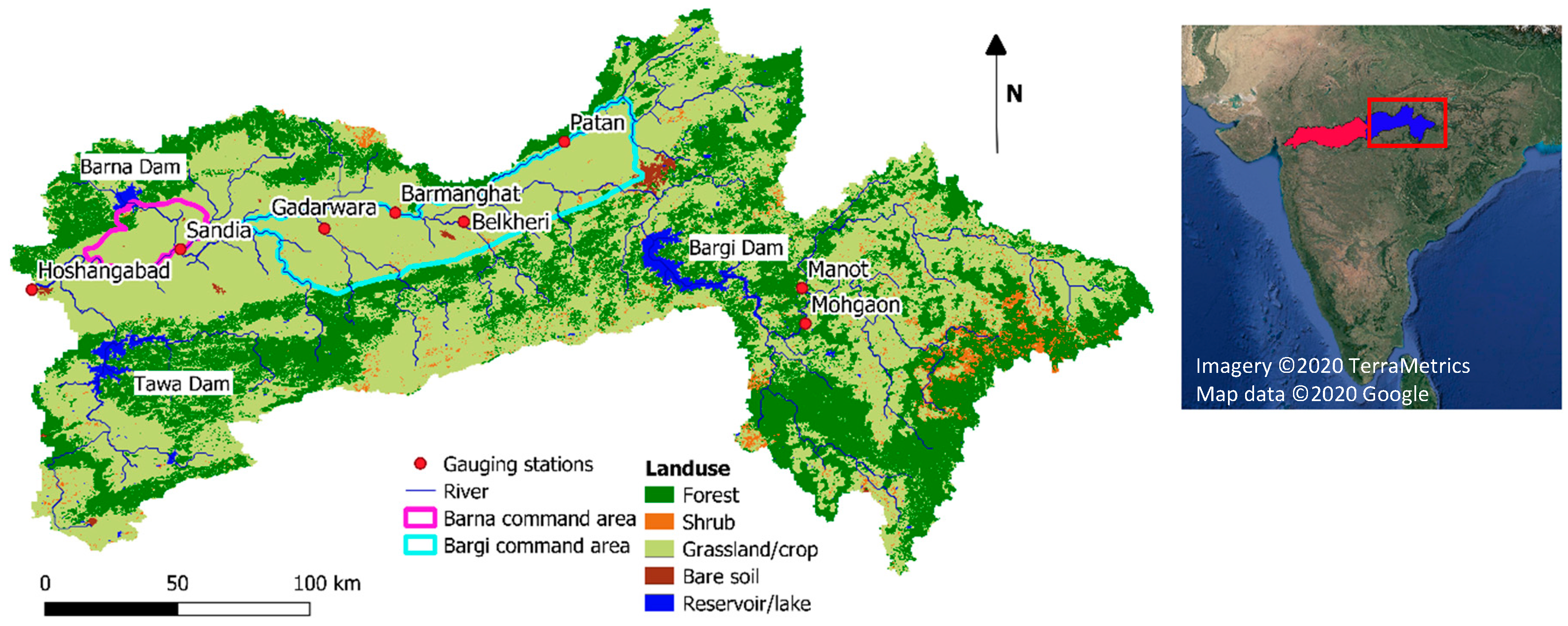
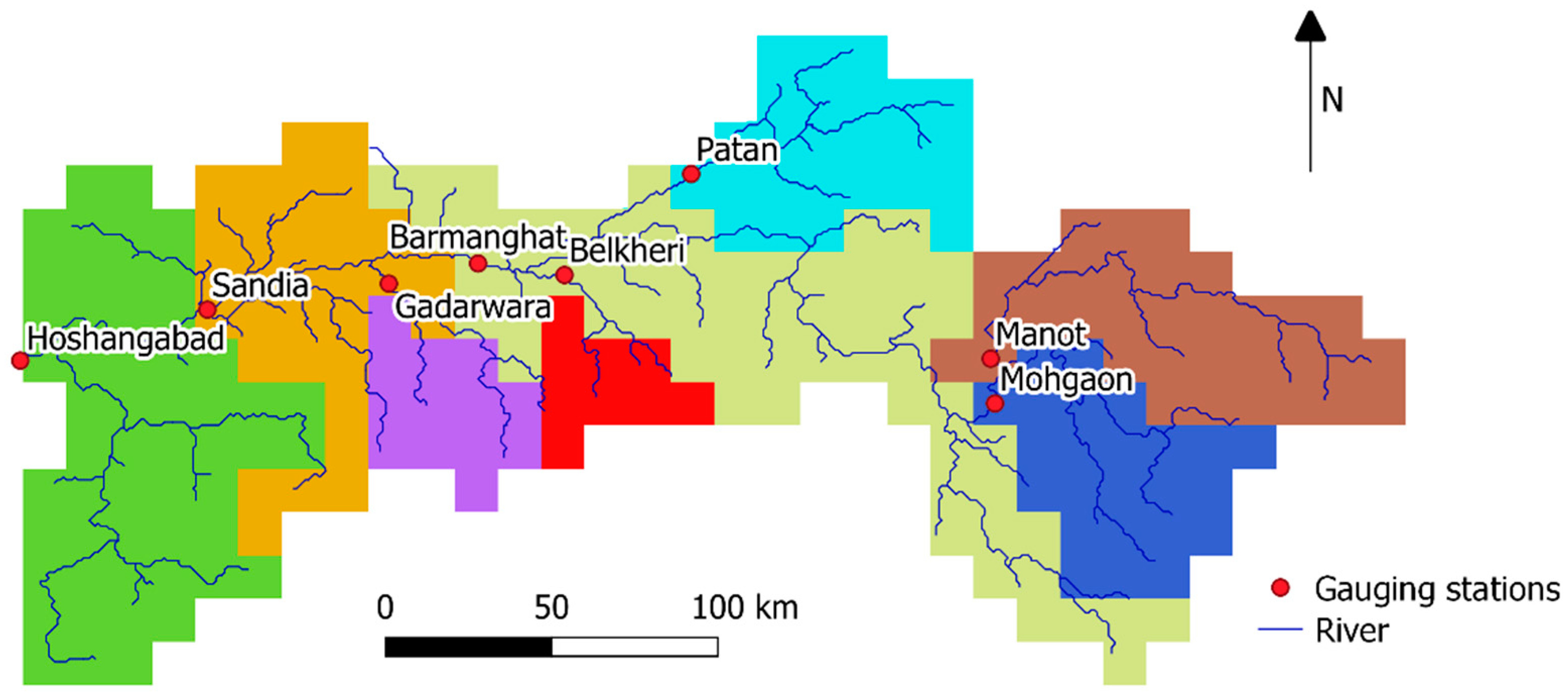
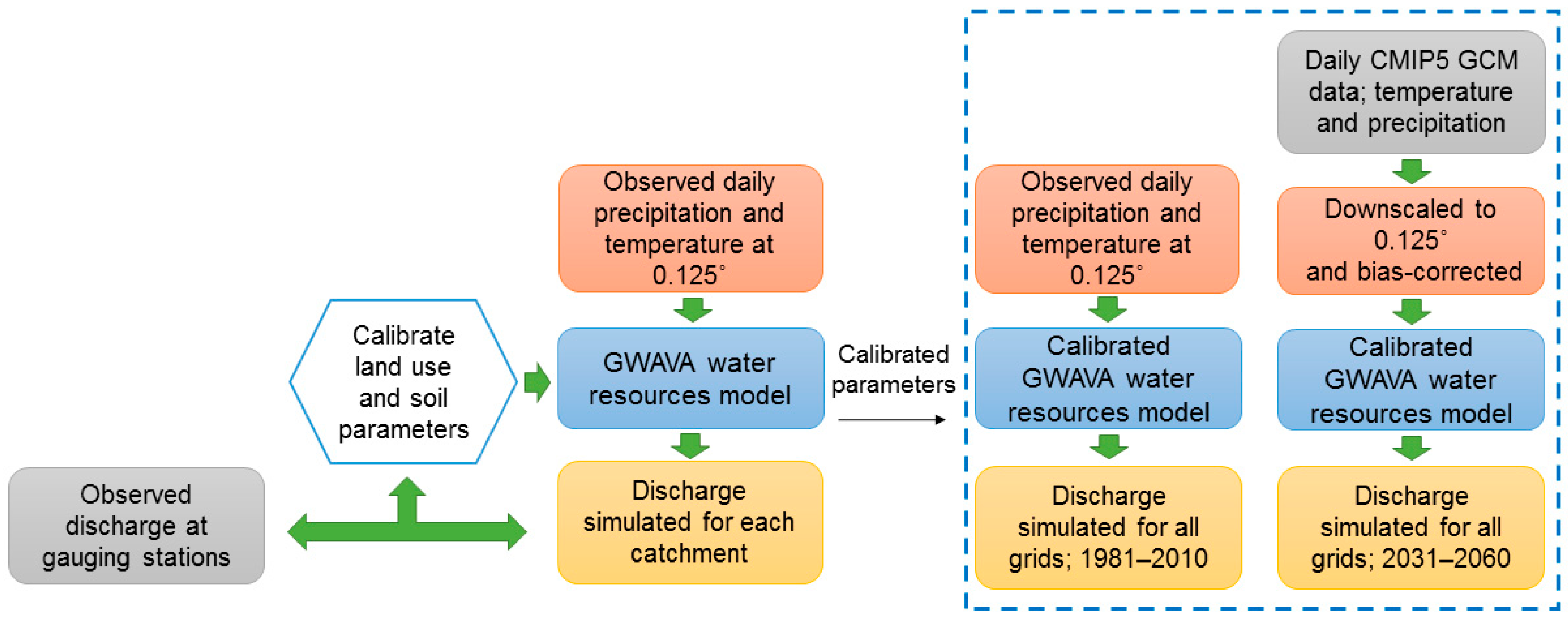
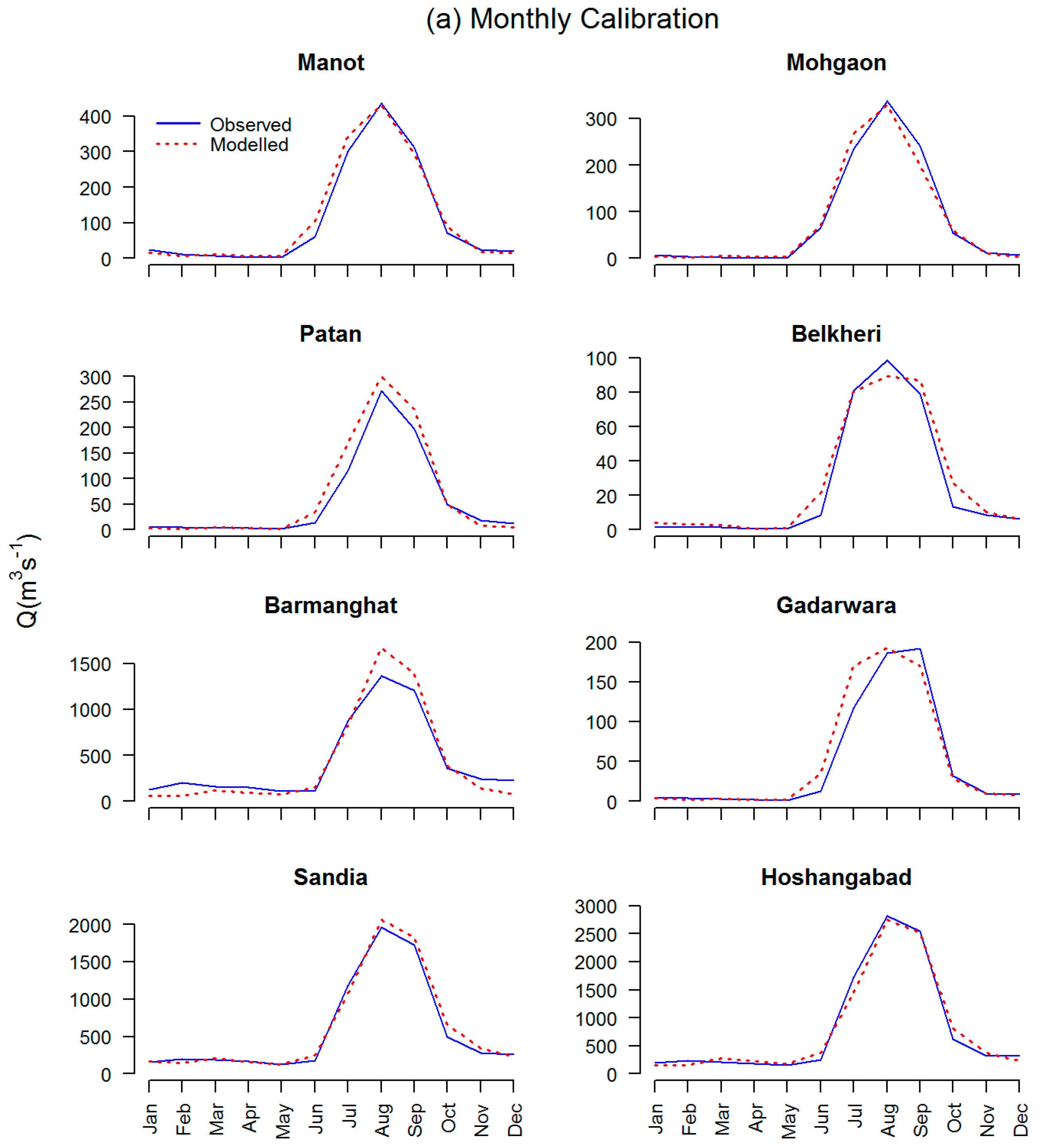
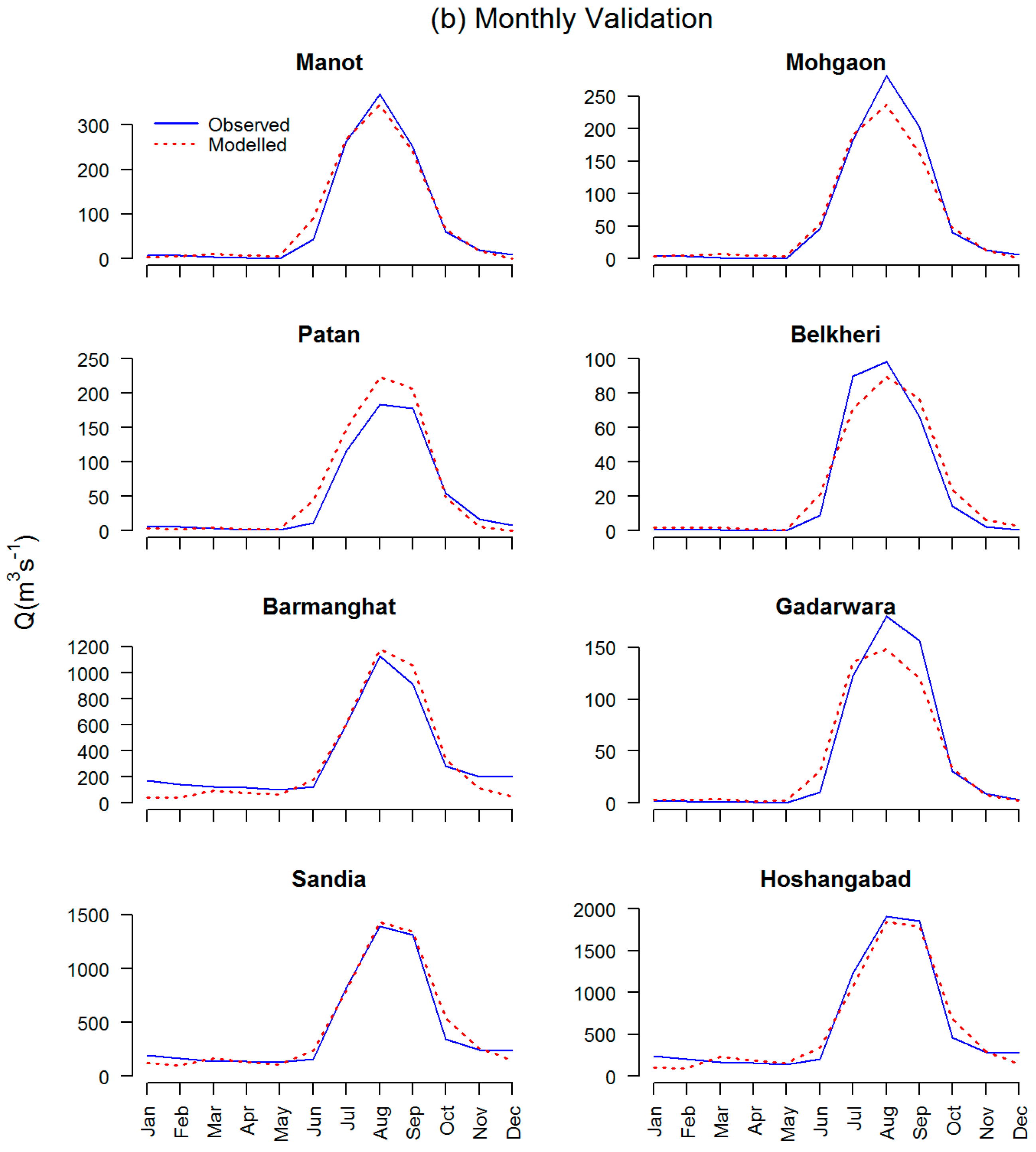
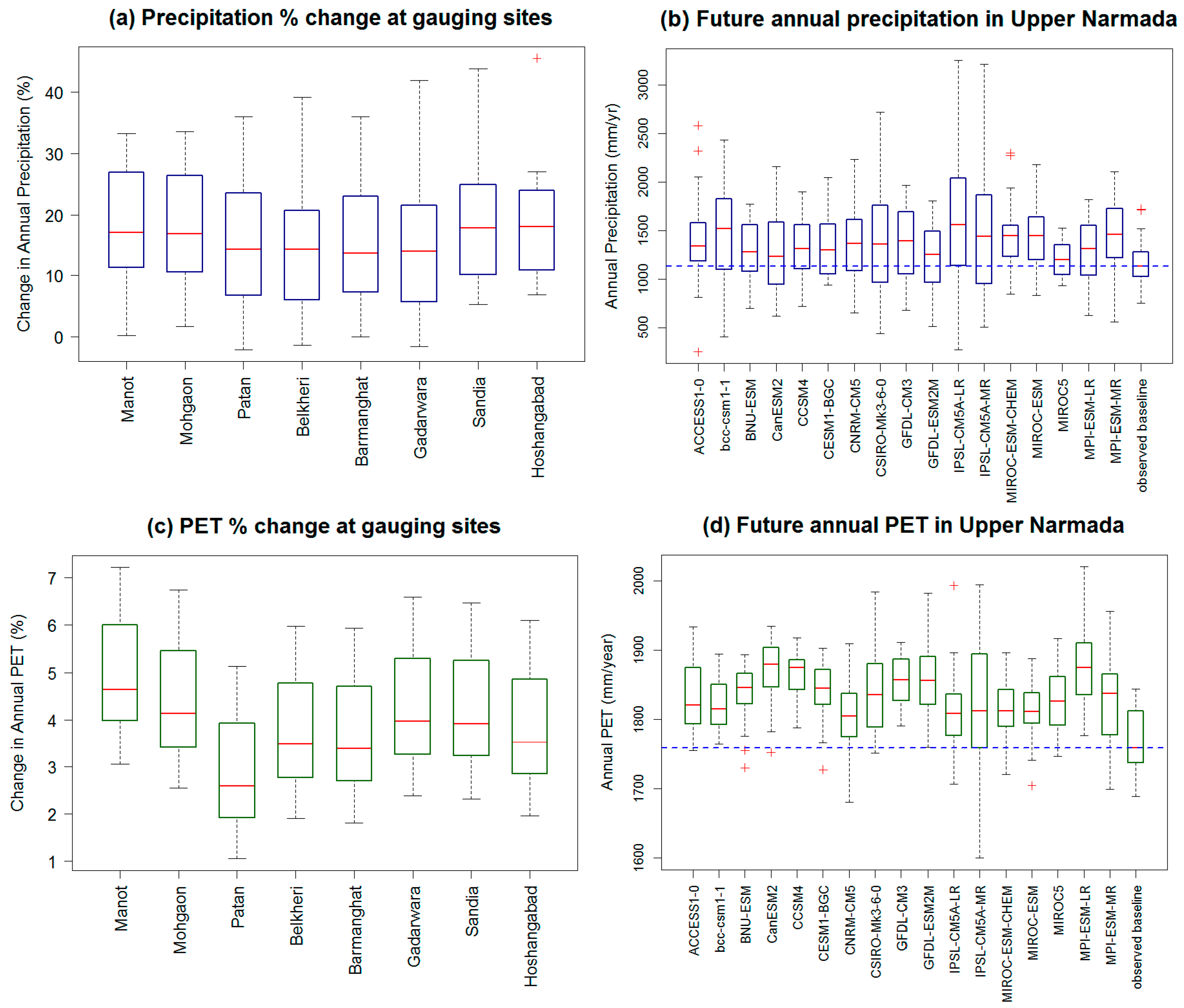

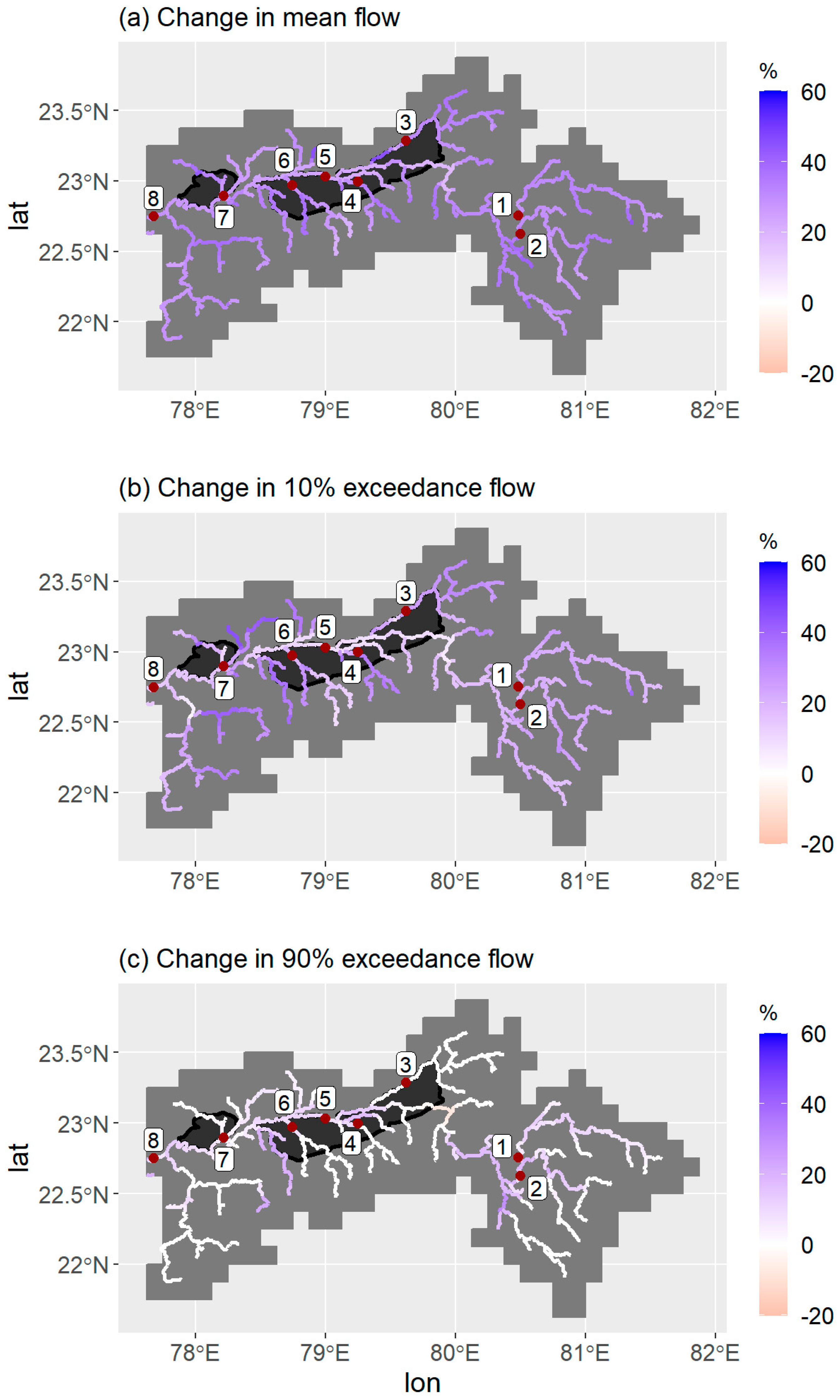
| Model Component | Key Inputs | Data Sources/Derivation |
|---|---|---|
| Topography | Topography | Extracted from SRTM (Shuttle Radar Topography Mission) 90 m resolution DEM (Digital Elevation Model) [49]. |
| Land use/vegetation | Land use distribution | USGS LULC map [50]. Reclassified to six land cover types: Forest, Shrub, Water bodies, Wetlands, Bare soil and Grass/cropland. |
| Soil | Soil classes | The spatial distribution of six soil classes was specified using a 1 km × 1 km grid based on a georectified and digitised soil map [51]. |
| River discharge | Discharge time series | India-WRIS (Water Resources Information System) [52]. |
| Catchment meteorology Precipitation and evapotranspiration modules. | Precipitation and Temperature | 0.25° × 0.25° gridded daily precipitation obtained from the IMD (India Meteorological Department) / NCC (National Climate Centre) High Spatial Resolution (0.25° × 0.25°) Long Period (1901–2013) Daily Gridded Rainfall Data Set Over India [53]. |
| Artificial influences | Reservoir and lake abstractions/operations, water body dimensions | Relevant information obtained from literature [38,54,55]. |
| Population and Domestic consumption | Indian Population Census [56,57]. | |
| Irrigated crops | Relevant information obtained from literature [58,59,60]. | |
| Water transfers | Relevant information obtained from literature and field surveys [55,61]. | |
| Cattle, sheep and goat populations | Indian Livestock Census [62]. |
| Dam | River | Year of Completion | Gross Storage Capacity (MCM) |
|---|---|---|---|
| Bargi | Narmada | 1988 | 3924.8 |
| Barna | Barna | 1978 | 539 |
| Tawa | Tawa | 1978 | 2312 |
| Gauge | River Reach | Catchment Area (km2) |
|---|---|---|
| Manot | Narmada | 4467 |
| Mohgaon | Burhner | 4090 |
| Patan | Hiren | 4795 |
| Belkheri | Sher | 2903 |
| Barmanghat | Narmada | 26,453 |
| Gadarwara | Shakkar | 2270 |
| Sandia | Narmada | 33,954 |
| Hoshangabad | Narmada | 44,548 |
| Station | Period | Dv | NSE | r | |
|---|---|---|---|---|---|
| Manot | Cal: 1990–2000 | 5.72 | 0.95 | 0.97 | |
| Val: 2001–2010 | 2.30 | 0.96 | 0.98 | ||
| Mohgaon | Cal: 1990–1996 | −0.55 | 0.87 | 0.88 | |
| Val: 2001–2010 | −6.7 | 0.90 | 0.95 | ||
| Patan | Cal: 1990–2000 | 16.93 | 0.92 | 0.97 | |
| Val: 2001–2010 | 17.8 | 0.90 | 0.97 | ||
| Belkheri | Cal: 1990–2000 | 11.07 | 0.87 | 0.94 | |
| Val: 2001–2010 | 5.2 | 0.80 | 0.89 | ||
| Barmanghat | Cal: 1992–2000 | 0.25 | 0.90 | 0.94 | |
| Val: 2001–2010 | −6.2 | 0.90 | 0.95 | ||
| Gadarwara | Cal: 1990–2000 | 8.60 | 0.92 | 0.96 | |
| Val: 2001–2010 | −5.4 | 0.64 | 0.80 | ||
| Sandia | Cal: 1990–2000 | 6.73 | 0.92 | 0.96 | |
| Val: 2001–2010 | 2.5 | 0.87 | 0.93 | ||
| Hoshangabad | Cal: 1990–2000 | 1.16 | 0.93 | 0.97 | |
| Val: 2001–2010 | −2.1 | 0.89 | 0.95 | ||
| Performance indicator | Excellent | Very good | Fair | Poor | Very poor |
| Dv | <5% | 5–10% | 10–20% | 20–40% | >40% |
| NSE | >0.85 | 0.65–0.85 | 0.50–0.65 | 0.20–0.50 | <0.20 |
| Model Name | Institution |
|---|---|
| ACCESS1-0 | Commonwealth Scientific and Industrial Research Organisation (CSIRO) and Bureau of Meteorology (BOM), Australia |
| bcc-csm1-1 | Beijing Climate Center, China Meteorological Administration |
| BNU-ESM | College of Global Change and Earth System Science, Beijing Normal University |
| CanESM2 | Canadian Centre for Climate Modelling and Analysis |
| CCSM4 | National Center for Atmospheric Research |
| CESM1-BGC | Community Earth System Model Contributors |
| CNRM-CM5 | Centre National de Recherches Météorologiques/Centre Européen de Recherche et de Formation Avancée en Calcul Scientifique |
| CSIRO-Mk3.6.0 | Commonwealth Scientific & Industrial Research Organisation in collaboration with the Queensland Climate Change Centre of Excellence |
| GFDL-CM3 | NOAA Geophysical Fluid Dynamics Laboratory |
| GFDL-ESM2M | |
| IPSL-CM5A-LR | Institut Pierre-Simon Laplace |
| IPSL-CM5A MR | |
| MIROC5 | Atmosphere and Ocean Research Institute (The University of Tokyo), National Institute for Environmental Studies, and Japan Agency for Marine-Earth Science and Technology |
| MIROC-ESM | |
| MIROC-ESM-CHEM | |
| MPI-ESM-LR | Max-Planck-Institut für Meteorologie (Max Planck Institute for Meteorology) |
| MPI-ESM-MR |
© 2020 by the authors. Licensee MDPI, Basel, Switzerland. This article is an open access article distributed under the terms and conditions of the Creative Commons Attribution (CC BY) license (http://creativecommons.org/licenses/by/4.0/).
Share and Cite
Rickards, N.; Thomas, T.; Kaelin, A.; Houghton-Carr, H.; Jain, S.K.; Mishra, P.K.; Nema, M.K.; Dixon, H.; Rahman, M.M.; Horan, R.; et al. Understanding Future Water Challenges in a Highly Regulated Indian River Basin—Modelling the Impact of Climate Change on the Hydrology of the Upper Narmada. Water 2020, 12, 1762. https://doi.org/10.3390/w12061762
Rickards N, Thomas T, Kaelin A, Houghton-Carr H, Jain SK, Mishra PK, Nema MK, Dixon H, Rahman MM, Horan R, et al. Understanding Future Water Challenges in a Highly Regulated Indian River Basin—Modelling the Impact of Climate Change on the Hydrology of the Upper Narmada. Water. 2020; 12(6):1762. https://doi.org/10.3390/w12061762
Chicago/Turabian StyleRickards, Nathan, Thomas Thomas, Alexandra Kaelin, Helen Houghton-Carr, Sharad K. Jain, Prabhash K. Mishra, Manish K. Nema, Harry Dixon, Mohammed M. Rahman, Robyn Horan, and et al. 2020. "Understanding Future Water Challenges in a Highly Regulated Indian River Basin—Modelling the Impact of Climate Change on the Hydrology of the Upper Narmada" Water 12, no. 6: 1762. https://doi.org/10.3390/w12061762
APA StyleRickards, N., Thomas, T., Kaelin, A., Houghton-Carr, H., Jain, S. K., Mishra, P. K., Nema, M. K., Dixon, H., Rahman, M. M., Horan, R., Jenkins, A., & Rees, G. (2020). Understanding Future Water Challenges in a Highly Regulated Indian River Basin—Modelling the Impact of Climate Change on the Hydrology of the Upper Narmada. Water, 12(6), 1762. https://doi.org/10.3390/w12061762





